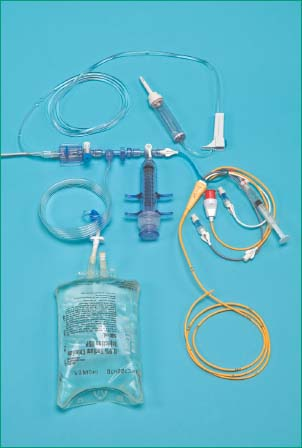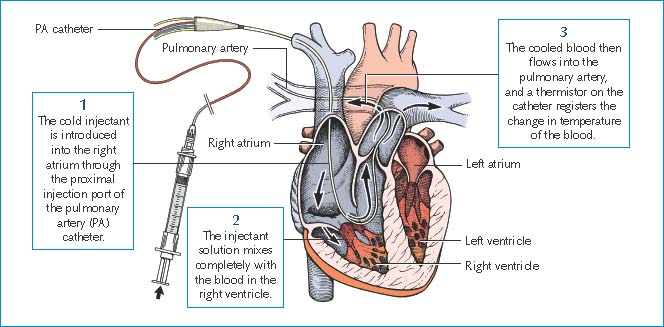Cardiac Output Measurement
Cardiac output—the amount of blood ejected by the heart—helps evaluate cardiac function. The most widely used method of calculating this measurement is the bolus thermodilution technique. Performed at the patient’s bedside, this technique evaluates the cardiac status of critically ill patients and those suspected of having cardiac disease.
To measure cardiac output, a quantity of solution colder than the patient’s blood is injected into the right atrium through the distal port on a pulmonary artery (PA) catheter. This indicator solution mixes with the blood as it travels through the right ventricle into the pulmonary artery, and a thermistor on the catheter registers the change in temperature of the flowing blood. (See Thermodilution method.) A computer then plots the temperature change over time as a curve and calculates flow based on the area under the curve.
Depending on the patient’s status and facility policy, iced or room-temperature injectant may be used. Although room-temperature injectant is more convenient and provides equally accurate measurements, iced injectant provides a stronger signal (because it’s colder) and may be more accurate in hypothermic patients, or when smaller volumes of injectant must be used (3 to 5 mL), as in patients with volume restrictions or in children.
Equipment
Thermodilution PA catheter in position ▪ output computer and cables (or a module for the bedside cardiac monitor) ▪ closed or open injectant delivery system ▪ 10-mL syringe ▪ 500-mL bag of dextrose 5% in water or normal saline solution ▪ crushed ice and water (for iced-injectant measurement).
Some bedside cardiac monitors measure cardiac output continuously, using either an invasive or a noninvasive method. If your bedside monitor doesn’t have this capability, you’ll need a free-standing cardiac output computer.
Preparation of Equipment
Perform hand hygiene1,2,3 and assemble the equipment at the patient’s bedside. Insert the closed injectant system tubing into the 500-mL bag of IV solution. Connect the 10-mL syringe to the system tubing, and prime the tubing with IV solution until it’s free of air. Then clamp the tubing. (See Cardiac output setup, page 114.)
If using iced injectant, place the coiled segment into a clean container and add crushed ice and water to cover the entire coil. Let the solution cool for 15 to 20 minutes. If using room-temperature injectant, connect the primed system to the stopcock of the proximal injectant lumen of the PA catheter. Next, connect the temperature probe from the cardiac output computer to the closed injectant system’s flow-through housing device. Connect the cardiac output computer cable to the thermistor connector on the PA catheter and verify the blood temperature reading. Finally, turn on the cardiac output computer and enter the correct computation constant, as provided by the catheter’s manufacturer. The constant is determined by the volume and temperature of the injectant as well as the size and type of catheter. The patient’s height and weight are also factored into the calculation.
Implementation
Confirm the patient’s identity using at least two patient identifiers according to your facility’s policy.4
Cardiac Output Setup
The photo below shows you how a cardiac output setup should look when it’s put together correctly and completely.
 |
Stay updated, free articles. Join our Telegram channel

Full access? Get Clinical Tree


Get Clinical Tree app for offline access

